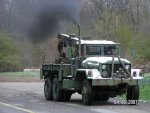Turbos are fun. I have been playing with them on diesels for quite a few years now. My daily driver is a compound turbo 7.3L light diesel that performs beautifully in terms of heat management, smoke control and power output.
When it comes to multiple turbos, there are a few good reasons for doing it. But first I think it might be good to lay down some ground work in terms of multiple turbo configurations and the terms associated with them.
Parallel: or "Twins" is the most common on spark-ignition engines. This is where each unit is responible for half of the load and recieves half of the exhaust energy. They are usually located one per bank on V-configuration engines, although they can just as easily be placed sided by side on a divided header inline engine. The reasoning on a smallish displacement engine making marginal power is largely just the "cool" factor, as a comparably capable single unit with a proper wastegate will produce equvelant results. Sometimes packaging lends itself to placing two units as well. However, with larger displacement engines, and or those producing higher than average power output, you can quickly reach the limits of available compressors that will move the required airflow for the power. In this case, you have to parralel the stage with two smaller, and more readily available turbochargers.
Sequential: Same basic premise of the parallel with the twist that the exhaust gas controlled so that it will initially provide most of its energy to the smaller turbocharger and then as manifold boost rises, a diverter of some form will begin to transistion the exhaust gas energy over to the larger turbocharger for higher rpm operation. This is most likely the least used configuration, although some OEM's actually employed this method for a time on some cars such as the supra.
Compound: In this configuration the exhaust path travels from manifold to the turbine inlet of the small charger (second stage) and then from the turbine outlet of the second stage to the turbine inlet of the large charger (first stage) and on from the turbine outlet of the first stage to the exhaust system if so equipped, otherwise directly to atmosphere. The air inlet track follows from atmosphere to first stage (large compressor) to second stage (small compressor) to engine intake manifold.
One of you already mentioned losing lower rpm power by running a larger turbo, but gaining higher rpm power. With compound turbocharging you can run a small turbo for spoolup and run a large one for high rpm power at the same time. Another benefit is that each compressor is now doing a fraction of the work for any given manifold boost (not half the work) so it's much easier to maintain excellent compressor efficiencies even with moderate to high manifold pressures.
Compound turbocharging and diesel engines go hand in hand in my opinion. You can produce substantial power without losing any low rpm power or dealing with excessive exhast gas temperature when operating in the lower rpm range. And visible smoke can be completely done away with.
As has already been said, adding a turbocharger to an engine that is already running clean without any tailpipe smoke will not result in any additional power. The same can be said of making a turbocharger swap on an engine that is already turbocharged but is not smoking at all currently. To add power you must add fuel. And brining in additional intake air affords you that option.
It should also be said that you can produce a higher volume of intake air charge to the engine without raising the boost. If one compressor is more thermally efficient at any given rpm/boost than another, it will make more power and smoke less without raising the pressure at all. Because the intake air charge while at the same pressure, is cooler and more dense. It is also possible to produce more power on less boost if the efficiency is high enough on the compressor of the new turbocharger vs that of the original.
Does anyone make head studs for these engines? If not, they are not cost prohibitive to produce in short runs. Especially for what would likely be a light duty application such as this. With a good head and block sealing surface and a set of headstuds the only thing you should be worrying about are the rods, block and bearings with increased cylinder pressure.
Either way, if the truck is smoking, you can definately clean that up with proper turbocharging. Intercooling would also be a good option for increasing the intake air volume, but I don't know if these things are running enough boost to see much gain from it.



